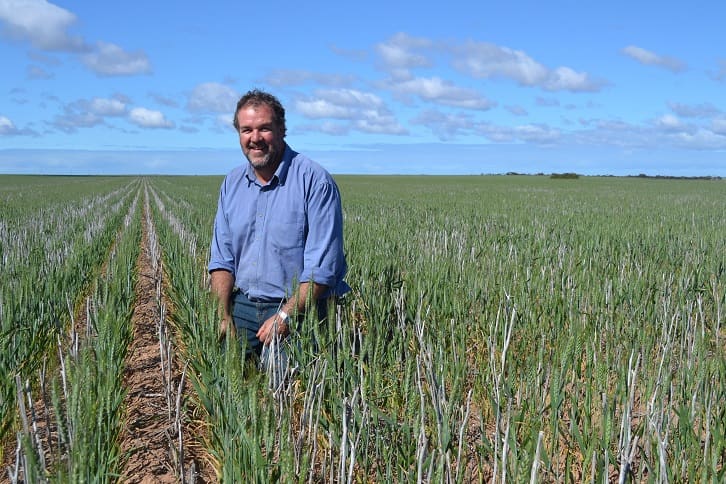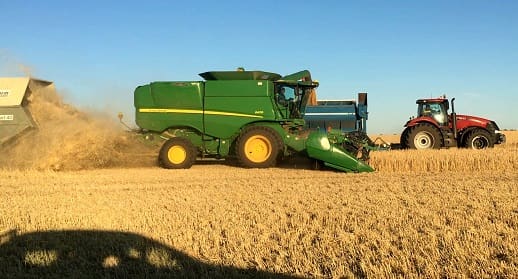
Peter Kuhlmann first adopted precision agriculture techniques nearly two decades ago on his South Australian farm, Mudmuckla. (Photo: Jarrad Delaney)
Case study
EYRE Peninsula farmer Peter Kuhlmann was quick to recognise the improvements in efficiency that precision agriculture tools gave him when he first adopted guidance and autosteer almost two decades ago.
……………….
Farm profile
Owner: Peter Kuhlmann
Farm location: Mudamuckla, Eyre Peninsula, SA
Annual rainfall: 291 millimetres
Soil types: Clay over sandy loam
Farm area: 14,500 hectares
Topography: Undulating dune/swale system
Enterprises: Wheat, barley, sheep
Average wheat yield: 1.2 tonnes per hectare
SPAA member: Yes
Agronomy consultant: Andy Bates, independent
……………………..
Top PA tips
- Consider potential efficiency gains when choosing to adopt PA tools
- On-farm trials are valuable in determining the most cost-effective seed and fertiliser inputs in a variable-rate system
- Use data to make more informed management decisions
…………………….
PA timeline
2000: Guidance
2003: Yield mapping
2004: Autosteer
2005: Variable rate
2005: Inter-row seeding
2005: On-farm trials
2012: Optical spot spray technology
2014: Water leak detection
…………………….
Why did you choose to adopt precision farming technology?
From the beginning, the efficiency gains derived from precision farming technology were obvious to me. I started by investing in GPS guidance and could instantly see the value in minimising overlap and minimising operator error. This allowed me to farm more efficiently.
Which technology tools or components have you adopted and (which do you) continue to adopt?
After purchasing an Outback lightbar with an Omnistar signal for guidance in 2000 we moved into yield mapping. I purchased New Holland TR99 harvesters which came with yield monitoring equipment as standard and then a year later we purchased Ag Leader’s SMS software to help us download and map yield data.
We continued to invest in PA technology in 2005 when we purchased an autosteer system from gps-Ag and a variable rate system from Ag Leader in the same year.
We have continued with most of the same technology and software up until 2018. Now we have installed Case IH’s AFS Pro 700 screen in the tractor for guidance using RTK in the main tractor.
About seven years ago (2012) we invested in a WeedIt optical spot spraying system. This enables us to only spray just the weeds over the summer period as opposed to applying a blanket spray over the whole paddock, which has led to some big savings in herbicides. We have found this system works best after the first blanket spray or where there is only Lincoln weed or melons to control.
On the livestock side, we have installed water leak detectors across the property, which transmits using a SIM card helps us identify where there are water leaks and fix them accordingly. This has enabled us to farm more efficiently as we don’t have to drive around trying to find water leaks and also results in significant savings in our water bill.

Peter Kuhlmann uses yield data to make more informed farming decisions such as where to put more or less fertiliser and seed in order to get the best dollar return.
What are the factors that motivate you to adopt and use each of the different tools or PA components?
It’s all about efficiency. PA technology allows us to put product where it is needed most, whether that be seed, fertiliser or pesticides. In our environment where soil types are so variable across the farm, technology such as auto-steer and variable rate are no-brainers. There are a number of benefits in re-directing fertiliser or higher rates of seed to where it is most needed in order to maximise yield.
What types of data and information are you collecting to guide your decision-making to adopt or not adopt each PA component?
Yield data is the main one. Collecting yield data enables us to analyse maps from paddocks across the whole farm and prescribe the appropriate seed and fertiliser regime for it.
In the early days of adopting variable rate we set up some on-farm trials in 2005 and 2006. The aim of this was to help determine the most cost-effective levels of seed and fertiliser inputs, which would then be used to set a paddock’s nutrient baseline. These trials found that standard rates of seed (60 kilograms per hectare), phosphorous (5.5kg/ha) and nitrogen (6kg/ha) were the most profitable, despite varying seasons. Starting in the 2019 season we are taking part in a Grains Research and Development Corporation-funded soil testing trial which utilises different fertiliser rates on three different paddocks. These results will add to my database and I may need to adjust my fertiliser strategy.
Has the adoption of PA increased profitability on your farm? How?
There are a lot of different components to PA but there is no doubt for me that technologies such as autosteer and auto shut-off can pay for themselves very rapidly. The yield benefit from PA is a bit harder to quantify but I think it is definitely worthwhile.
How are you using the data generated by PA? Is it leading to further practice change? If so, what kind of practice change?
I am using the data – particularly yield data – to make more informed farming decisions such as where to put more or less fertiliser and seed in order to get the best dollar return. There are a number of benefits to the adoption of variable rate, particularly in our environment where soil types are so variable.
We aren’t necessarily adopting any further technologies, just expanding the ones we are currently using. Besides the WeedIt and water leak detection system, I have probably plateaued in my adoption of further PA tools in the past 10 years.
Who is influencing you with the adoption of PA?
I am a member of SPAA and the information the organisation provides has been and continues to be an influence in my adoption of PA technologies. When we were setting up our yield mapping and variable rate systems we had Ed Cay from gps-Ag helping us to analyse the data and prescribe maps, but now that set-up work is done we don’t use a consultant in the PA space. The manufacturers of machinery and PA technologies also provide plenty of information regarding different PA tools.
Are you planning to adopt more or less of these various precision farming technology components in the future?
I am hoping to continue utilising the technology I currently have and to further refine it. There are still improvements we can make in our systems, such as creating permanent boundaries and AB lines and identifying obstacles in the paddocks.
We are looking at options to upgrade some of the technology now, such as the seeder controller. As far as any new technology goes, if there is something which I think could benefit the business then I will explore it further and decide whether or not it fits with our operation.
Contact details: Peter Kuhlmann, 0428 258 032, [email protected]
…………………….
Source: Society of Precision Agriculture Australia (SPAA)
This case study was supported by SPAA through funding from the South Australian Grain Industry Trust Fund as part of project SPAA118 – Conversations with Farmers: Agricultural Practice Change with the “PA-Early Adopters”
Produced by AgCommunicators P/L and Lightning Designs
More case studies available from SPAA website: www.spaa.com.au
Grain Central: Get our free daily cropping news straight to your inbox – Click here

HAVE YOUR SAY